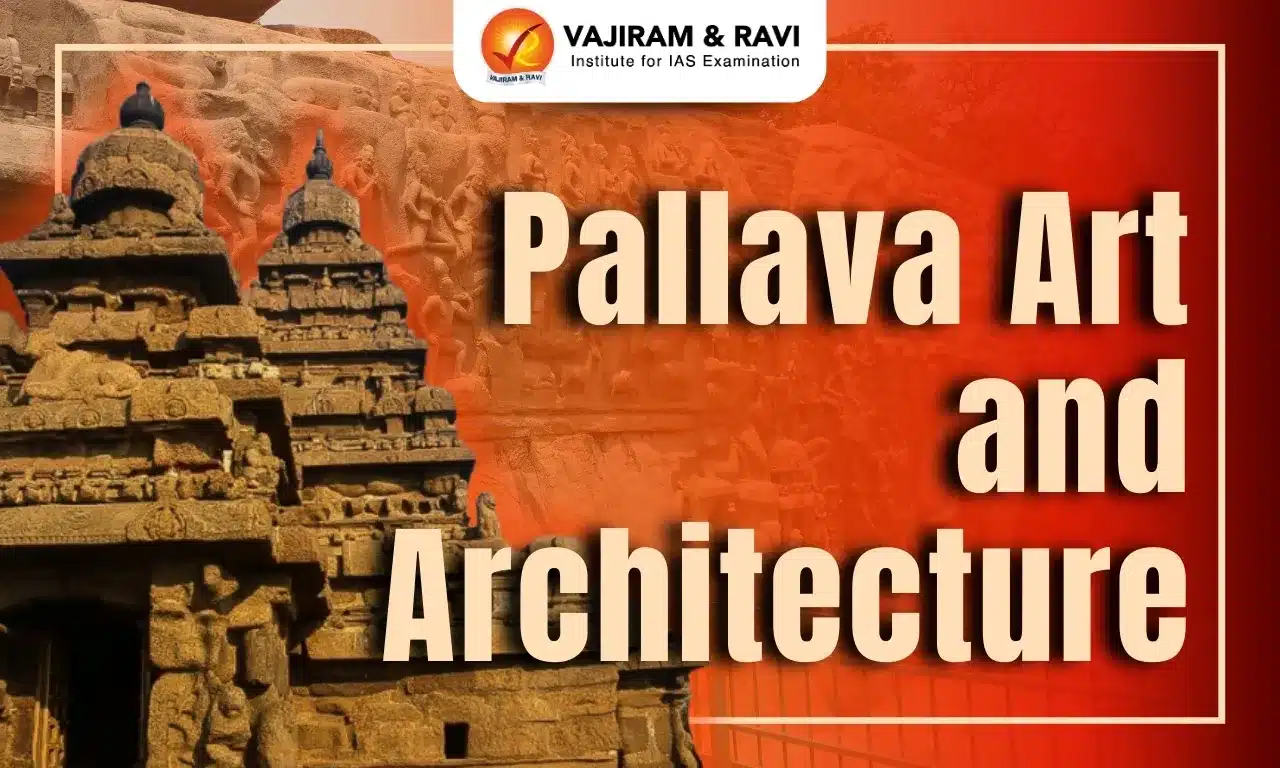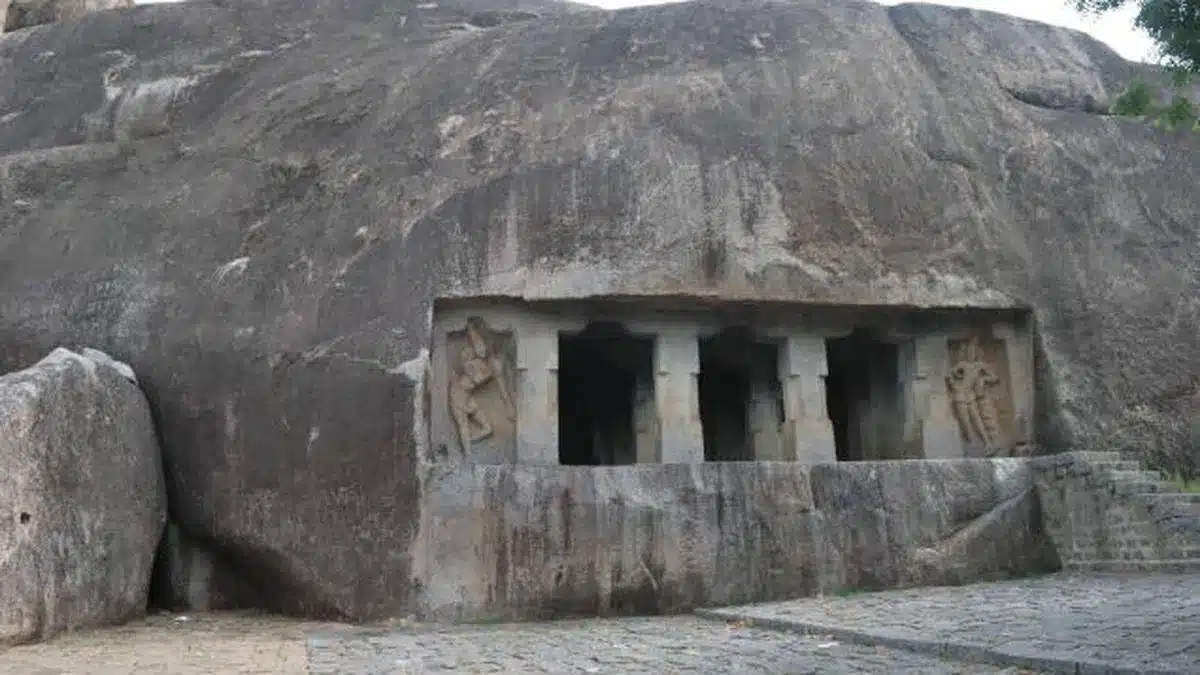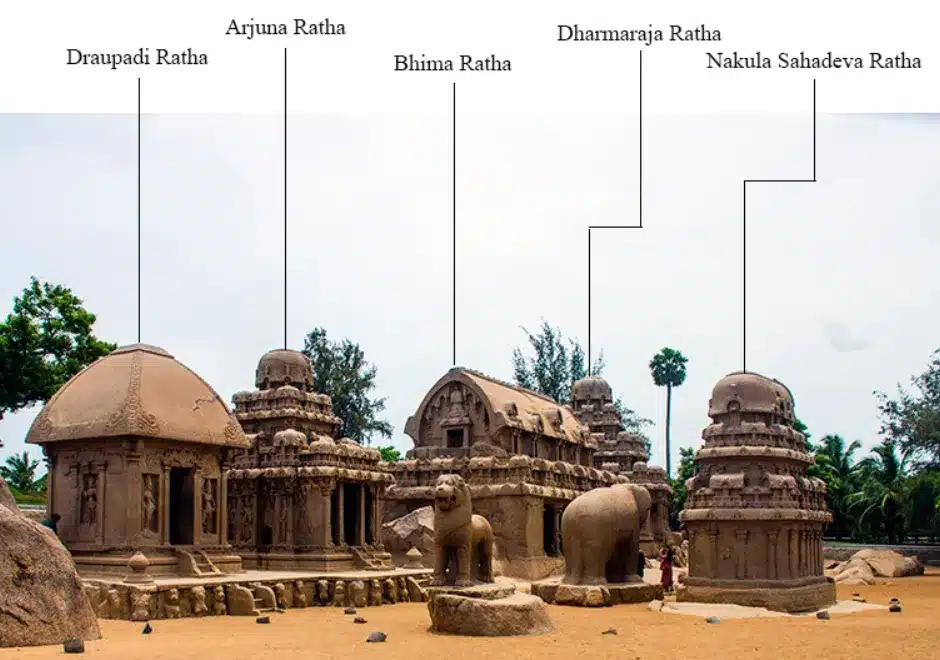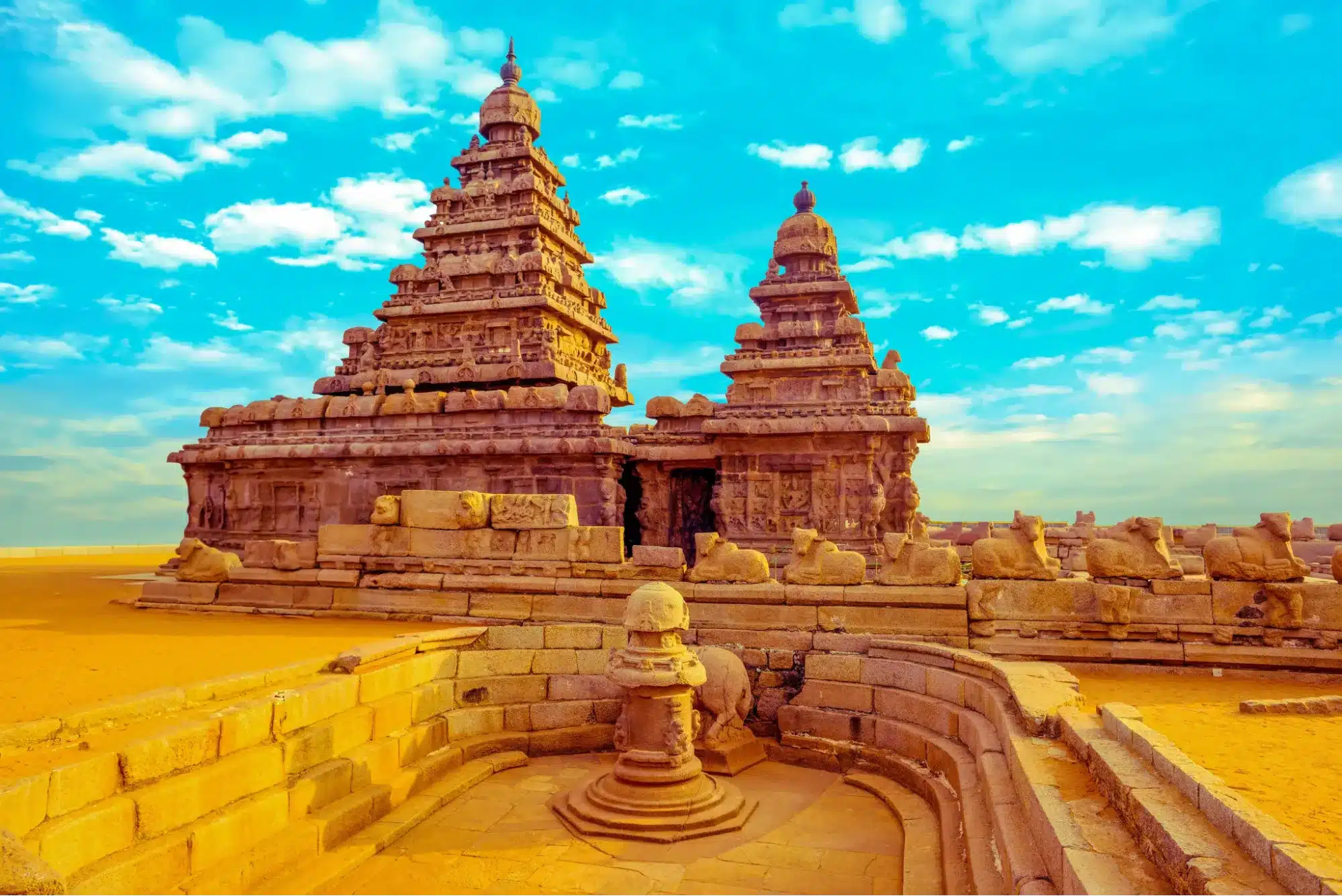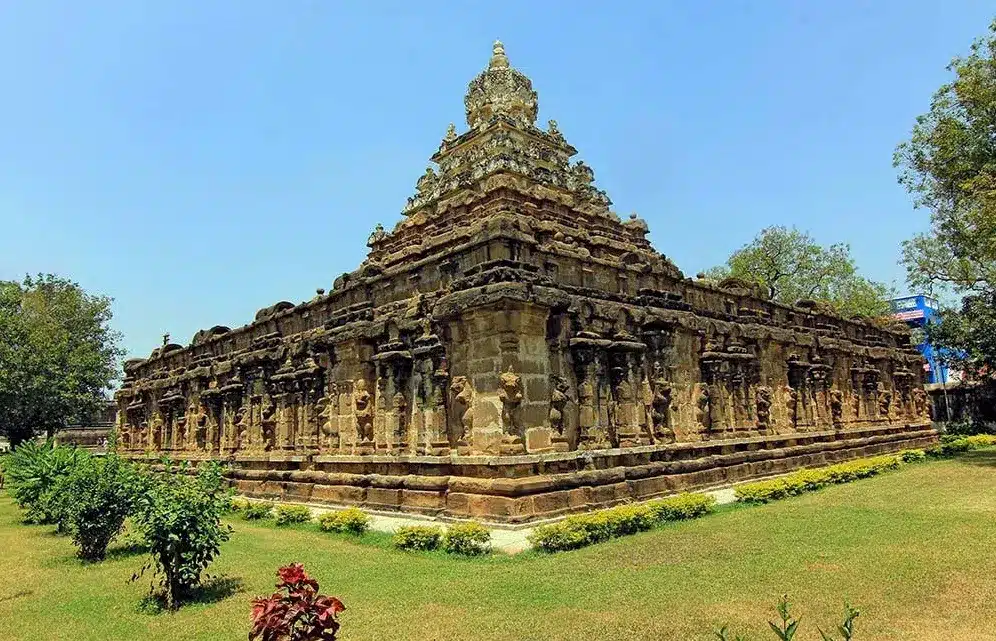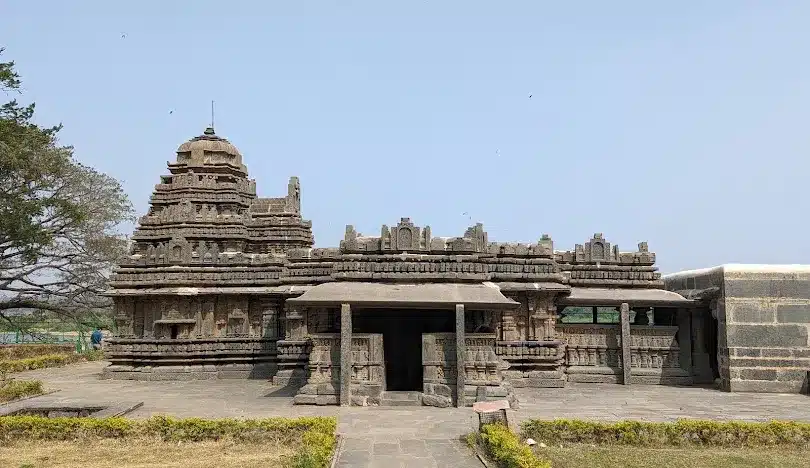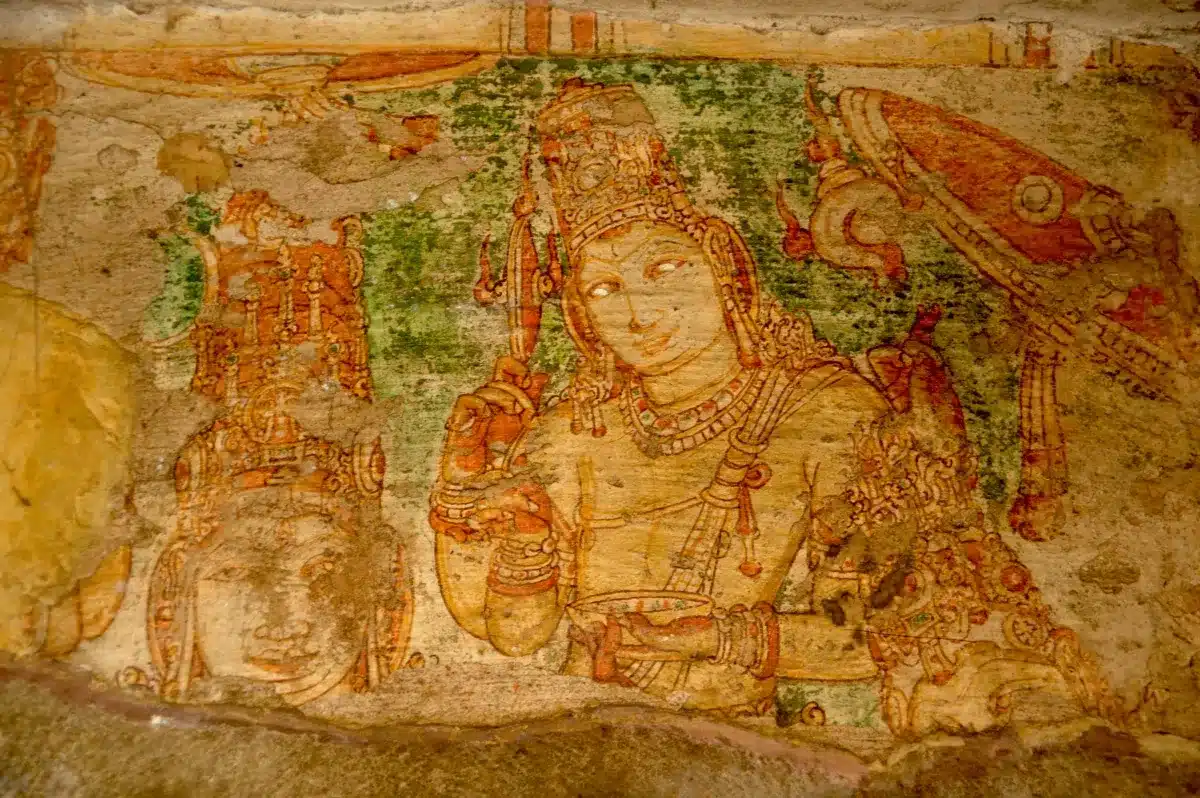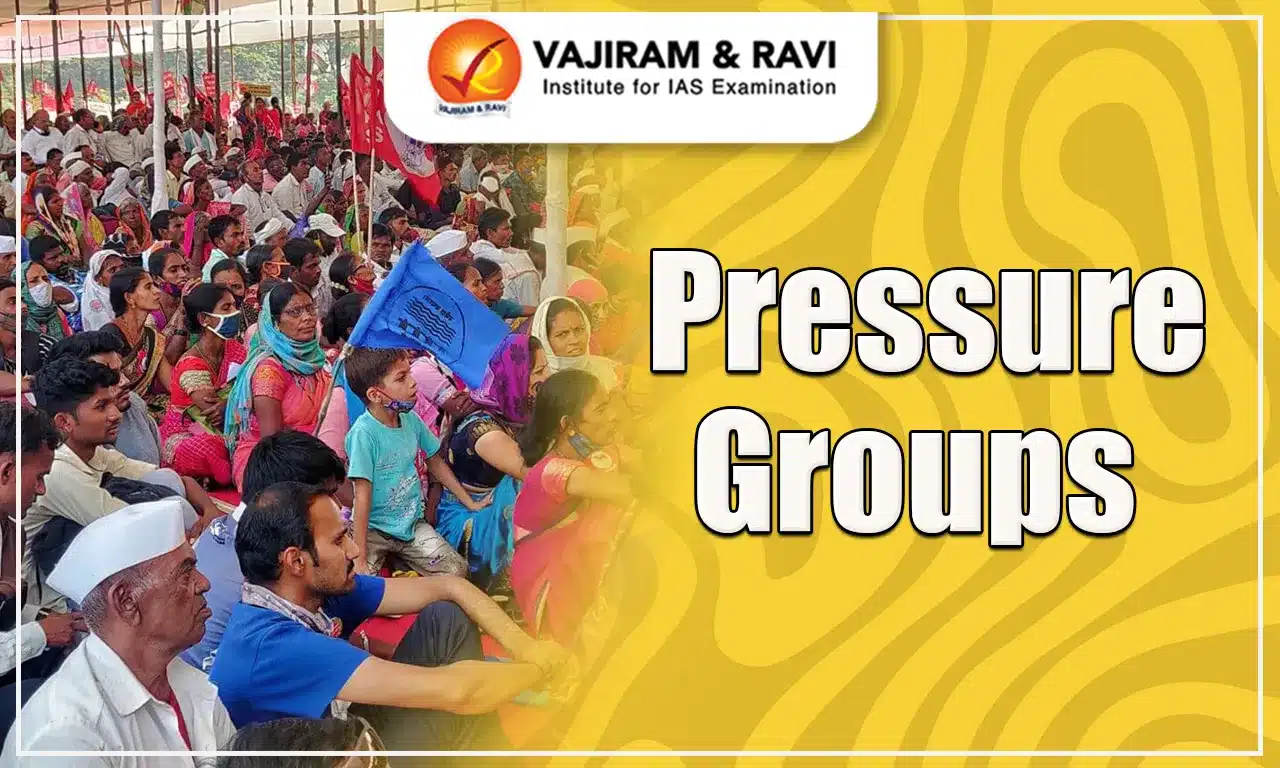Pallava art and architecture thrived during the Pallava Dynasty's reign from 275 CE to 897 CE, laying the foundation for medieval South Indian architecture. Their architectural evolution occurred in four stages: the Mahendra style (rock-cut temples), Mamalla style (Mandapas and Rathas), Rajasimha style (structural temples), and Nandivarman style, culminating in the Dravida style. Notable monuments from this period include the Vaikuntha Perumal Temple, the Shore Temple, and the Pancha Rathas at Mahabalipuram.
In addition to architecture, the Pallavas were patrons of music, dance, painting, and literature. Their contributions included intricate sculptures, murals, and inscriptions in Sanskrit and Tamil. The Pallava dynasty played a vital role in shaping South Indian cultural and artistic heritage, influencing subsequent Chola architecture and South Indian art forms.
Pallava Art and Architecture Pallava Dynasty
The Pallava dynasty was a prominent South Indian dynasty that ruled much of Tamil Nadu and parts of Andhra Pradesh between the 3rd and 9th centuries CE. Their capital was initially in Kanchipuram, which became one of the major cultural, religious, and artistic centers in South India under Pallava rule.
- Pallavas of Kanchi, emerging in the 6th century, were a dominant South Indian dynasty. Narasimhavarman I (630-668 AD), known for his military victories, defeated Pulakesin II and developed Mahabalipuram into a prominent port city. His successor, Narasimhavarman II (695-722 AD), maintained peace, sent embassies to China, and made significant contributions to Pallava architecture, including constructing the Shore Temple and the Kailashnath Temple.
- The Pallavas had a centralized monarchy, dividing their kingdom into Kottams administered by royal officers, while autonomous village assemblies like the Sabha and Urar managed local governance.
- Pallava society was religiously diverse, supporting Buddhism, Jainism, Saivism, Vaishnavism, and the Bhakti movement. Their economy was agrarian, supplemented by trade, taxes, and the use of gold and silver coins.
- The dynasty declined due to continuous wars with the Chalukyas and Pandyas, culminating in the defeat of Aparajitavarman by the Imperial Chola ruler.
Pallava Art and Architecture Style of Architecture
Pallava period was a great era of temple building. Not only did the Pallavas introduce the art of excavating temples from the rock but also the Dravidian style of temple architecture began with the Pallava rule.
- It was a gradual evolution starting from the cave temples to monolithic rathas to structural temples that culminated in the Dravida style of temple architecture during the Chola period.
- The gradual evolution of temple architecture under the Pallava dynasty can be seen in four stages:
Mahendravarman Style of Architecture
The monuments constructed during the reign of Mahendravarman I (610-630 AD), known as the Mahendra group of temples, are rock-cut pillared halls carved into mountain faces. These structures reflect the influence of Jain art and architecture, following the prototype of Jain temples of the time, showcasing the detailed craftsmanship and design elements characteristic of Jain architectural traditions.
- New Temple Style: The Mahendra group of temples marked the emergence of a new style of rock-cut temple construction, moving away from traditional materials like bricks, iron, lime, and wood.
- Mandapas: These were the first temple types that saw the introduction of the apsidal garbhagriha, and beautifully carved toranas above doorways.
- Dvarapalas: The presence of Dvarapalas is a prominent feature and these images were depicted in their frontal aspect.
- Sculptural Relief: The relief of most Pallava sculptures tended to be shallower than in the Deccan because of the hardness of the stone which has kept ornament to a minimum.
- Notable examples: Cave temples of Mamallapuram, Mandagapattu, Pallavaram, Mamandur and Mahendravadi. Lalitankuresvara temple at the base of Rockfort, Tiruchirapalli.
Mamalla Style of Temple Architecture
The second group of rock-cut monuments belong to the Mamalla group from 630 to 668 AD.
Mahabalipuram (Mamallapuram) was the centre of architecture during the time of Narsimhavarman I.
- Styles of temples: In the Mamalla style of architecture, two styles of temples can be seen they are Mandapas and Rathas.
- Mandapas: The Mandapas of the Mamalla style are more ornamental than the Mahendravarman style of Mandapas. The prominent feature of Mandapas is their pillars built on the heads of lions.
- Famous Mandapas of the Mamalla style include the Varaha Mandapa and the Mahisasurmardini Mandapa, among others.
- Rathas: The second component was the free-standing monolithic shrines called ‘Rathas’ which were constructed alongside pillared halls. They were mostly built of granite stones.
- One of this style's best examples is the Pancha Pandava Rathas of Mahabalipuram.
- Draupadi Ratha is the smallest ratha, like a small bracket. It is designed as a Hindu temple.
- Dharmaraja Ratha is one of the best examples of a ratha designed like Vihara. It is the biggest among all the rathas.
- Bhim Ratha and the Ganesha Ratha are the best examples of the rathas built in the shape of a Chaitya.
- One of this style's best examples is the Pancha Pandava Rathas of Mahabalipuram.
- Sculpture: In the Sculptures, Arjuna's Penance at Mahabalipuram is notable.
Rajasimha Style of Temple Architecture
The structural phase started with the Rajsimha Style of Temple architecture. Free-standing temples were constructed with stone and mortar. The structural temples consist of two groups - the Rajasimha group (690-800 AD) and the Nandivarman group (800-900 AD).
- Structural Technique: Stones were independently carved into square and rectangular shapes, then arranged to form walls and ceilings.
- Mandapa: Muga Mandapa (pillared hall), Artha Mandapa (entrance hall), and Vimana (tower) above the walls, with a Vimana constructed above the walls.
- Sculptures: Walls and pillars adorned with sculptures in low or high relief.
- Materials Used: This style represented a time of experimentation, as the temples utilized materials like bricks, wood, and stone.
- Notable examples: Ishwariya Temple and Mukunda Temple.
- Shore Temple of Mahabalipuram: Recognized as a UNESCO World Heritage site and a fine representation of Pallava architecture.
- Kailasha Temple, Kanchi: Showcases elements of the Dravida style with Gopuram, pillars, Mandapas, and Vimana, begun by Rajasimha and completed by Mahendravarman II.
Nandivarman Style of Temple Architecture
Pallava architecture attained full maturity during the Nandivarman style of temple architecture period. These provided the basic model on which the later massive Brihadeeswarar Temple at Thanjavur and the temples of Gangaikonda Cholapuram were constructed by Cholas.
- Nandivarman Group of Monuments: The best example is the Vaikuntaperumal Temple at Kanchipuram, built by Parameshwaravarman II and dedicated to the Bhagwat religion. The internal walls display paintings of war scenes, coronations, and Ashwamedha yagna.
- Decline of Pallava Architecture: After the decline of the Rajasimha style, Pallava architecture saw a downturn. Later rulers could not build large monuments, resulting in smaller, less ornamented temples, lacking innovation.
- Examples of Later Temples: The Mukteshawara Temple and Matangeshwara Temple in Kanchi.
Pallava Art and Architecture Art
Pallavas were great patrons of the art and their cultural contributions remain exemplary. Architecture and other forms of art like music, dance, sculptural art, and painting, developed under the patronage of the Pallavas.
Pallava Art and Architecture Sculpture
Pallava sculpture is known for exquisite Mandapas, carved from a single rock, featuring intricate sculptures depicting Puranic stories. A notable example is the depiction of Goddess Durga’s attack on Mahishasura at the Mahishasura Mardhini Mandapa.
- Open Art Galleries: A significant aspect of Pallava artistry, with open-air carvings on large rocks. For example, at Mamallapuram, numerous miniature images are intricately carved on the wall of a large rock. Key depictions include:
- Fall of the River Ganga from Lord Shiva’s head
- Arjuna’s penance.
- Ascetics, deer, monkeys, and a meditative cat.
Pallava Art and Architecture Paintings
Pallava paintings from this period include the beautiful Sittannavasal murals and the Dakshinchitra, a commentary compiled during the reign of Mahendravarman I, who held the title Chittirakkarapuli.
- Vaikunthaperumal temple paintings are probably dated from the 8th-9th centuries A.D. There are traces of paint everywhere, including on pillars and in the niches of the central tower. These Pallava paintings are specimens of the classical or Ajanta style.
Pallava Art and Architecture Music and Dance
The Mamandur and Kudumiyanmalai inscriptions, attributed to the Pallavas, mention musical notes and instruments, showing the importance of music during their time. The Alwars and Nayanmars composed their hymns using musical notes, while instruments such as the yaazhi, mridangam, and murasu gained prominence.
- Notably, Mahendravarman I and Narasimhavarman I were music experts, and sculptures from this era depict various dancing postures.
- Some prosperous temples even maintained groups of dancers.
- Additionally, the popularization of musical instruments like the flute, and the dance form of Bharatanatyam at temples was made popular due to the Bhakti movement.
Pallava Art and Architecture Literature
Pallavas were great patrons of Sanskrit and Tamil languages. They played a crucial role in the evolution of Tamil script and promoted epigraphy as a medium of recording history and culture. Additionally, they were strong supporters of learning. Their capital, Kanchi, served as an esteemed centre of education that attracted students from across India and abroad.
- Sanskrit literature:
-
- Bharavi, the great Sanskrit scholar and the author of Kiratarjuniyam was the court poet of Pallava King Singhabahu or Singhavishnu.
- Dandin adorned the court of Narasimhavarman II and wrote Kavyadharsha.
- Mahendravaraman I composed the Sanskrit play Mattavilasaprahasanam.
- Tamil literature:
- Bhakti saints (Nayanmars and Alwars) wrote hymns in Tamil (Devaram of Nayanmars and the Nalayradivyaprabandam of Alwars).
- Perundevanar, patronized by Nandivarman II, translated the Mahabharata called Bharathavenba in Tamil.
- Nandikkalambagam is another important work but the author is unknown.
Pallava Art and Architecture UPSC PYQs
Q1: In the context of the history of India, consider the following pairs:
Term Description
- Eripatti Land, revenue from which was set apart for the maintenance of the village tank
- Taniyurs Villages donated to a single Brahmin or a group of Brahmins
- Ghatikas Colleges are generally attached to the temples
Which of the pairs given above correctly matched? (UPSC Prelims 2016)
(a) 1 and 2
(b) 3 only
(c) 2 and 3
(d) 1 and 3
Ans: (d)
Q2: With reference to the art and archaeological history of India, which one among the following was made earliest? (UPSC Prelims 2015)
(a) Lingaraja Temple at Bhubaneswar
(b) Rock-cut Elephant at Dhauli
(c) Rock-cut Monuments at Mahabalipuram
(d) Varaha Image at Udayagiri
Ans: (b)
Q3: Evaluate the nature of Bhakti Literature and its contribution to Indian culture. (UPSC Mains 2021)
Q4: The rock-cut architecture represents one of the most important sources of our knowledge of early Indian art and history. Discuss. (UPSC Mains 2020)
Last updated on November, 2025
→ Check out the latest UPSC Syllabus 2026 here.
→ Join Vajiram & Ravi’s Interview Guidance Programme for expert help to crack your final UPSC stage.
→ UPSC Mains Result 2025 is now out.
→ UPSC Notification 2026 is scheduled to be released on January 14, 2026.
→ UPSC Calendar 2026 is released on 15th May, 2025.
→ The UPSC Vacancy 2025 were released 1129, out of which 979 were for UPSC CSE and remaining 150 are for UPSC IFoS.
→ UPSC Prelims 2026 will be conducted on 24th May, 2026 & UPSC Mains 2026 will be conducted on 21st August 2026.
→ The UPSC Selection Process is of 3 stages-Prelims, Mains and Interview.
→ UPSC Result 2024 is released with latest UPSC Marksheet 2024. Check Now!
→ UPSC Prelims Result 2025 is out now for the CSE held on 25 May 2025.
→ UPSC Toppers List 2024 is released now. Shakti Dubey is UPSC AIR 1 2024 Topper.
→ UPSC Prelims Question Paper 2025 and Unofficial Prelims Answer Key 2025 are available now.
→ UPSC Mains Question Paper 2025 is out for Essay, GS 1, 2, 3 & GS 4.
→ UPSC Mains Indian Language Question Paper 2025 is now out.
→ UPSC Mains Optional Question Paper 2025 is now out.
→ Also check Best IAS Coaching in Delhi
Pallava Art and Architecture FAQs
Q1. Who was the founder of Pallavas?+
Q2. What was the chief feature of Pallava architecture?+
Q3. What are the four stages of Pallava architecture?+
Q4. Which art and architecture is famous in Tamil Nadu?+
Q5. What were the contributions made by the Pallavas in art and literature?+
Tags: pallava art and architecture quest UPSC Art and Culture Notes



